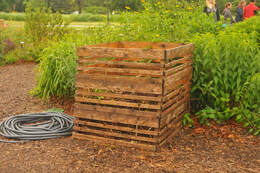
- Turn the pile at least once a month to rotate materials from the center and promote decomposition. The pile will heat up as it decomposes and cool as decomposition slows.
- Create a depression in the top of the pile to allow water to collect and slowly seep through the layers of the mound.
- When deciding where to establish a compost pile, look for a water source. Proximity to supplemental water will allow you to keep the pile wet even during periods of drought which is important for efficient decomposition.
- Smaller materials decompose faster. When possible, shred materials before adding them to the compost heap. This is especially true for “browns” such as dry leaves and twigs.
- Fats and meats should not be added to the compost. They will attract wildlife.
- Grass clippings from a lawn treated with crabgrass killer should not be composted. If crabgrass preventer or dandelion killer has been used on the lawn, the clippings can be composted after the third mowing. (Cynthia Domenghini)
 RSS Feed
RSS Feed
